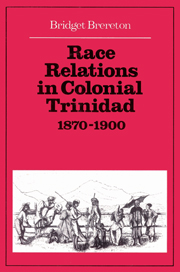Book contents
- Frontmatter
- Contents
- Acknowledgements
- Glossary
- 1 Introduction
- 2 The environment
- 3 The white elite
- 4 Education and mobility
- 5 The rise of a coloured and black middle class
- 6 The urban labouring population
- 7 The black rural masses
- 8 The souls of black folk
- 9 The Indians
- 10 Racism and race relations: the divided society
- Abbreviations
- Notes
- Bibliography
- Index
7 - The black rural masses
Published online by Cambridge University Press: 08 October 2009
- Frontmatter
- Contents
- Acknowledgements
- Glossary
- 1 Introduction
- 2 The environment
- 3 The white elite
- 4 Education and mobility
- 5 The rise of a coloured and black middle class
- 6 The urban labouring population
- 7 The black rural masses
- 8 The souls of black folk
- 9 The Indians
- 10 Racism and race relations: the divided society
- Abbreviations
- Notes
- Bibliography
- Index
Summary
The majority of the black masses were countrymen, living in the rural villages, or in small settlements and isolated homesteads in the newly opened districts in the interior. Most of them were in agriculture, as wage labourers, or peasant cultivators, or cocoa contractors; others were craftsmen employed in the villages or on the estates; some were hunters, lumbermen and fishermen. They were the descendants of Trinidad slaves, of West Indian settlers, of Venezuelan immigrants, or of liberated Africans.
We have already investigated the British West Indian immigrants, and we noted that they mostly settled in Port of Spain, San Fernando, and the larger villages; for the most part, they did not engage in plantation labour or peasant agriculture. This was not the case with the Venezuelan immigrants or with the liberated Africans, who formed important elements in the rural population. One other racial group was swiftly passing away: the Amerindians, the aboriginal inhabitants of Trinidad. By 1870 only a few pure-blooded Amerindians survived. The Spanish authorities had gathered the indigenes together in missions, at Cumana, Siparia, Savannah Grande, Arima, and elsewhere. In each mission, the Indians were ruled by a Corregidor nominated by the Governor; lands were held in common, and the Catholic priest exercised paternal powers of discipline and control. Their numbers declined very fast as Trinidad entered die mainstream of plantation development after the 1780s. On the north coast, for instance, the surviving Amerindian families were brought together in the mission at Cumana (Toco); but they disappeared inexorably, and the cholera epidemic of 1854 apparently exterminated nearly all the north coast Indians. By 1885 there were only perhaps a dozen half-caste Amerindian families on the north coast.
- Type
- Chapter
- Information
- Race Relations in Colonial Trinidad 1870–1900 , pp. 130 - 151Publisher: Cambridge University PressPrint publication year: 1980



